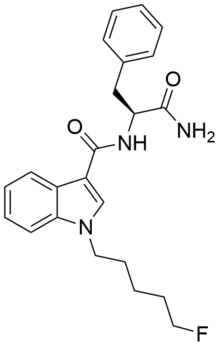PX-1
Tools
Actions
General
Print/export
In other projects
Appearance
From Wikipedia, the free encyclopedia
This is an old revision of this page, as edited by Testem (talk | contribs) at 22:31, 18 October 2020 (UK legal status - see Talk:PX-1 for explanation). The present address (URL) is a permanent link to this revision, which may differ significantly from the current revision.
Pharmaceutical compound
 | |
| Legal status | |
|---|---|
| Legal status |
|
| Identifiers | |
| |
| CAS Number | |
| PubChem CID | |
| ChemSpider | |
| UNII | |
| Chemical and physical data | |
| Formula | C23H26FN3O2 |
| Molar mass | 395.478 g·mol−1 |
| 3D model (JSmol) | |
| |
| |
PX-1 (also known as 5F-APP-PICA and SRF-30) is an indole-based synthetic cannabinoid that has been sold online as a designer drug.[1][2]
Legality
Sweden's public health agency suggested classifying PX-1 as hazardous substance on November 10, 2014.[3]
PX-1 is listed in the Fifth Schedule of the Misuse of Drugs Act (MDA) and therefore illegal in Singapore as of May 2015.[4]
See also
References
- ^ "PX 1". Cayman Chemical. Retrieved 15 July 2015.
- ^ Presley BC, Logan BK, Jansen-Varnum SA (December 2019). "Phase I metabolism of synthetic cannabinoid receptor agonist PX-1 (5F-APP-PICA) via incubation with human liver microsomes and UHPLC-HRMS". Biomedical Chromatography. 34 (3): e4786. doi:10.1002/bmc.4786. PMID 31863591.
- ^ "Cannabinoider föreslås bli klassade som hälsofarlig vara" (in Swedish). Folkhälsomyndigheten. Retrieved 16 July 2015.
- ^ "Misuse of Drugs Act". Singapore Government. 30 April 2015. Retrieved 24 July 2015.
| Receptor (ligands) |
| ||||||||||||||||||||||||||||||
|---|---|---|---|---|---|---|---|---|---|---|---|---|---|---|---|---|---|---|---|---|---|---|---|---|---|---|---|---|---|---|---|
| Transporter (modulators) |
| ||||||||||||||||||||||||||||||
| Enzyme (modulators) |
| ||||||||||||||||||||||||||||||
| Others |
| ||||||||||||||||||||||||||||||
| |||||||||||||||||||||||||||||||
This cannabinoid related article is a stub. You can help Wikipedia by expanding it. |
Retrieved from "https://en.wikipedia.org/w/index.php?title=PX-1&oldid=984221527"
Hidden categories:
